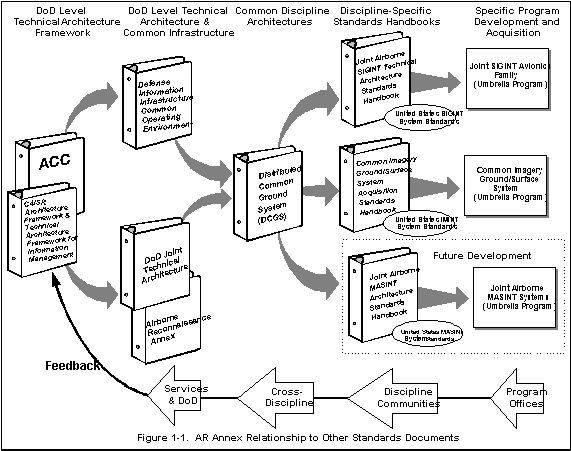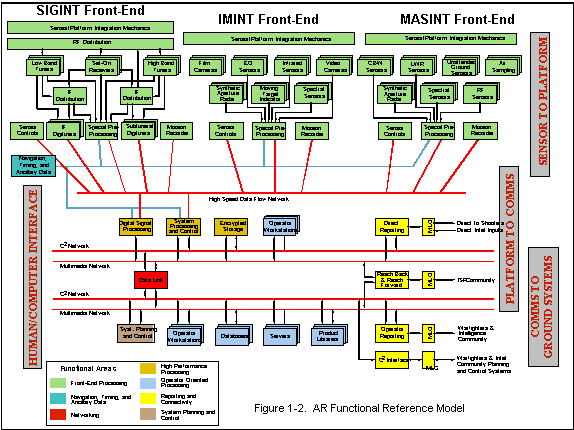

| This annex is managed by the Defense Airborne Reconnaissance Office (DARO). |

The DoD JTA AR Annex will be maintained by DARO through cooperation with the Architecture Coordination Council (ACC) and its associated steering groups and working groups. Questions or comments concerning technical details presented in this annex may be submitted to the ACC or directly to DARO.

|
Table 1-1. AR FRM Functional Components |
|
Front-end processing functions |
|
Navigation, timing, and ancillary data |
|
Networking functions |
|
High performance processing functions |
|
Operator-oriented processing functions |
|
Reporting and connectivity functions |
|
System planning and control functions |
| Table 1-2. AR Annex Part 2 Sections |
|||
| Section Service Area | Corresponding JTA Service Area |
DARP-Unique Service Area |
Exceptions, Additions, or Extensions Identified |
| 2.2 Information Processing |
|
|
|
| 2.3 Information Transfer |
|
|
|
| 2.4 Information Modeling & Information |
|
||
| 2.5 Human Computer Interfaces |
|
|
|
| 2.6 Information System Security |
|
||
| 2.7 Sensor Platform Interface |
|
||
| 2.8 Collection Management, Mission Planning & Control |
|
||
|
Table 2-1. CIGSS Component Programs |
|
Joint Service Image Processing System (JSIPS) program - including
Navy, Air Force, and Marine Corps |
|
Army's Enhanced Tactical Radar Correlator (ETRAC) |
|
Army's Modernized Imagery Exploitation System (MIES) |
|
Imagery parts of the Air Force's Contingency Airborne Reconnaissance
System (CARS) |
|
Marine Corps' Tactical Exploitation Group (TEG) programs |
|
Korean Combined Operational Intelligence Center (KCOIC) imagery
systems |
|
Pacific Air Forces Interim National Exploitation System (PINES)
|
|
Mobile Intelligence Processing Element (MIPE) |
|
Integrated Deployable Processing System (IPDS) |
|
Processing/exploitation capability for the U-2R SENIOR YEAR Electro-Optical
(E/O) sensor (SENIOR BLADE) |
|
Table 2-2. Airborne Reconnaissance Dissemination Systems |
|
Joint/Global Broadcast Service (JBS/GBS) |
| Tactical Information Broadcast Service (TIBS) |
| Tactical Receive Equipment and Related Applications (TRAP) Data
Dissemination System (TDDS). |
| Tactical Reconnaissance Intelligence Exchange System (TRIXS) |
SIGINT front-end standards are concerned primarily with on-board systems that receive and process radio frequency (RF) from low frequency (LF), 30 kHz to 300 kHz, through extra high frequency (EHF), 30 GHz to 300 GHz, received by the platform antenna/antenna arrays. These RF antenna/antenna array types may be omni-directional, directional, beam-steered, steered dish, interferometric, or spinning dish. In addition, the SIGINT front-end functional elements include the RF distribution, low and high band tuners, set-on receivers, IF distribution IF digitizers, and sub-band tuners/digitizers, and channelizers. SIGINT sensor/platform interface standards are identified in the following reference:
|
Table 2-3. MASINT Technology Areas |
|
Chemical and Biological Weapons (CBW) |
|
LASINT/Laser Warning Receivers (LWR) |
|
Unattended Ground Sensors (UGS) |
|
Spectral (Non-literal) |
|
Air Sampling |
|
Radio Frequency (RF) |
|
Synthetic Aperture Radar Phase History (SAR PH) |
Airborne ISR sensor systems, other than battery-driven systems, must be designed to operate on standard aircraft electrical power. MIL-STD-704E is the governing standard for all manned platforms, whereas JII 91081 governs the power interface design for all unmanned platforms. The following standards are mandated for AR systems:
High data rate digital imagery: